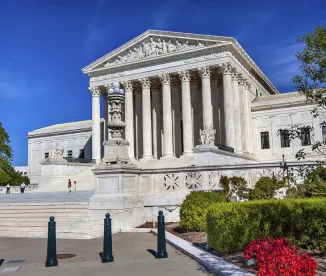The Supreme Court ruled today that the 1998 amendments to the federal securities laws did not strip state courts of jurisdiction over class actions alleging violations of only the Securities Act of 1933. The Court further held that those amendments do not empower defendants to remove those federal-law cases from state to federal court.
The Court's unanimous decision in Cyan, Inc. v. Beaver County Employees Retirement Fund(No. 15-1439) ensures that, if a plaintiff chooses to file a state-court class action asserting only Securities Act claims arising from a public offering of a listed security, the case will remain in state court – and will not be subject to the procedural requirements that Congress imposed on federal-court securities class actions. The preservation of a state-court forum thus increases the difficulty of coordinating or consolidating related cases filed in multiple federal and state courts.
Statutory Background
In the wake of the 1929 stock-market crash, Congress enacted the Securities Act of 1933 and the Securities Exchange Act of 1934. The Securities Act applies to public offerings of securities, provides for concurrent federal- and state-court jurisdiction, and bars removal of Securities Act claims from state to federal court. The Exchange Act was designed for aftermarket transactions and provides for exclusive federal jurisdiction.
The growth of state-court suits asserting federal claims arising from public offerings of securities dates back to federal legislation enacted in 1995 to control abusive securities litigation. In 1995, Congress enacted the Private Securities Litigation Reform Act of 1995 (the "PSLRA"), which dramatically changed the federal securities laws. The PSLRA imposed heightened pleading requirements and protections for forward-looking statements, mandated a stay of discovery pending any motion to dismiss, established a process for appointment of lead plaintiff and lead counsel in securities class actions, prescribed rules governing class-action settlements, and placed limits on awards of attorneys' fees.
The PSLRA's pleading requirements and discovery stay apply to all claims asserted under the Securities Act and the Exchange Act, regardless of forum. But the procedural provisions – such as the lead-plaintiff selection process, the rules governing settlements, and the fee limitations – apply only to federal-court class actions.
When members of the plaintiffs' bar sought to avoid the PSLRA's class-action restrictions by filing state-law claims and federal Securities Act claims in state courts, Congress enacted the Securities Litigation Uniform Standards Act of 1998 ("SLUSA"). Section 77p of SLUSA preempts state-law securities claims for listed securities and permits the removal of covered class actions (defined generally as any damages action on behalf of 50 or more persons) alleging such claims. As to federal-law claims under the Securities Act, SLUSA amended the Act in three potentially relevant ways:
-
SLUSA added the italicized exception to the Securities Act's concurrent-jurisdiction provision: "The district courts of the United States . . . shall have jurisdiction of offenses and violations under this subchapter . . . and, concurrent with State and Territorial courts, except as provided in section 77p of this title with respect to covered class actions, of all suits in equity and actions at law brought to enforce any liability or duty created by this subchapter." 15 U.S.C. § 77v(a) (the italicized language is known as the "except clause").
-
SLUSA amended the Securities Act's anti-removal provision by adding the italicized exception: "Except as provided in section 77p(c) of this title, no case arising under this subchapter and brought in any State court of competent jurisdiction shall be removed to any court of the United States." 15 U.S.C. § 77v(a).
-
The new § 77p(c) provides: "Any covered class action brought in any State court involving a covered security . . . shall be removable to the Federal district court for the district in which the action is pending, and shall be subject to subsection (b)," which preempts state-law claims. 15 U.S.C. § 77p(c).
In the 20 years since SLUSA's enactment, lower courts split on whether the Securities Act's original creation of concurrent jurisdiction and prohibition of removal survived the SLUSA amendments, or whether SLUSA succeeded in channeling all Securities Act class actions to federal court. California in particular became a hotbed for state-court Securities Act claims challenging securities offerings. The Supreme Court has now resolved the issue.
Supreme Court's Decision
The Court first ruled that § 77v(a)'s "except clause" – providing that state courts have concurrent jurisdiction of Securities Act claims "except as provided in section 77p of this title with respect to covered class actions" – "does nothing to deprive state courts of their jurisdiction to decide class actions brought under the [Securities] Act." The Court construed the "except clause" to apply only to securities class actions based on state law. SLUSA preempts those claims and allows them to be removed to federal court, where they must be dismissed. "But the section says nothing, and so does nothing, to deprive state courts of jurisdiction over class actions based on federal law. That means the background rule of § 77v(a) – under which a state court may hear [Securities] Act suit[s] – continues to govern."
The Court next held that SLUSA's § 77p(c) does not authorize removal of Securities Act class actions from state to federal court. State-law securities class actions can be removed, but "federal-law suits like this one – alleging only [Securities] Act claims – are not 'class action[s] . . . as set forth in subsection (b).' So they remain subject to the [Securities] Act's removal ban."
Implications
The Cyan decision has significant potential implications for Securities Act class actions: it could lead to a multiplicity of related cases challenging securities offerings, with few practical ways to avoid duplicative and possibly conflicting lawsuits.
First, no general procedural mechanism exists to transfer or consolidate related cases filed in federal and state courts. The normal methods of corralling related federal cases into a single forum – consolidation, transfers, multidistrict-litigation proceedings – do not work as between the federal and state systems. Federal and state courts can agree to coordinate with each other, and one court might choose to stay or adjourn proceedings in deference to the other, but parties in a federal suit probably cannot shut down state-court proceedings if the state court is unwilling to agree. The federal Anti-Injunction Act's exceptions (in aid of jurisdiction, and to protect and effectuate judgments) might allow a federal court to enjoin state-court proceedings if the federal case has advanced to the settlement phase or has gone to judgment. But the Act could pose hurdles in the early stages of a federal suit.
Second, Securities Act class actions filed in state court are not subject to the PSLRA's procedural provisions embodied in § 27(a) of the Securities Act. Those provisions include the certification requirement (requiring plaintiffs to certify that they authorized the filing of the case and did not buy the relevant security at counsel's direction or in order to participate in the action), the restriction on attorneys' fees (requiring that any fees and expenses awarded to class counsel "not exceed a reasonable percentage of the amount of any damages and prejudgment interest actually paid to the class"), and the rules governing disclosure of settlement terms to class members.
Perhaps most important, state-court Securities Act class actions are not subject to the PSLRA's lead-plaintiff appointment process, which requires the plaintiff to notify the putative class of the filing of the complaint and give all other class members 60 days to apply to be lead plaintiff. The court then appoints a lead plaintiff from among the applicants (presumptively choosing the one who sustained the largest loss) and also appoints lead counsel. The lead-plaintiff process thus tries to avoid duplicative class actions. But if state-court suits can go forward without regard to this process, competing class actions with two (or more) sets of class representatives and class counsel might proceed in federal and state courts, and the cases probably cannot be consolidated in or transferred to a single forum.
Third, the Cyan decision does not address "mixed" cases that plead both Securities Act claims and state-law claims. Cyan involved only Securities Act claims, and it instructs that those claims are not removable to federal court. But it also confirms that class actions asserting state-law claims based on alleged securities misconduct are preempted and removable. So if a case pleads both Securities Act and state-law claims, can the whole case be removed? Cyan does not answer the question, but future cases will likely explore this issue – unless the plaintiffs' bar seeks to avoid it by pleading only Securities Act claims in their state-court complaints.
Fourth, we might see movement in Congress to amend the Securities Act to allow removal of Securities Act class actions and perhaps even to eliminate concurrent jurisdiction over those cases. The Supreme Court understood the odd result of preempting state-law claims and requiring their dismissal or removal to federal court (where they should then be dismissed), while prohibiting the removal of federal claims and requiring them to remain in state court. The Court noted: "We do not know why Congress declined to require as well that [Securities] Act class actions be brought in federal court." But the Court concluded that, "[i]f further steps are needed, they are up to Congress."





 />i
/>i
